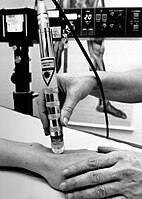
Photo from wikipedia
Acute lung injury (ALI) is a severe, multifactorial lung pathology characterized by diffuse alveolar injury, inflammatory cell infiltration, alveolar epithelial barrier rupture, alveolar edema, and impaired pulmonary gas exchange, with… Click to show full abstract
Acute lung injury (ALI) is a severe, multifactorial lung pathology characterized by diffuse alveolar injury, inflammatory cell infiltration, alveolar epithelial barrier rupture, alveolar edema, and impaired pulmonary gas exchange, with a high rate of mortality; and sepsis is its most common cause. The mechanisms underlying ALI due to systemic inflammation were investigated experimentally by systemic lipopolysaccharide (LPS) administration. Photobiomodulation (PBM) has been showing good results for several inflammatory diseases, but there are not enough studies to support the real benefits of its use, especially systemically. Considering that ALI is a pathology with high morbidity and mortality, we studied the effect of systemic PBM with red light-emitting diode (LED) (wavelength 660 nm; potency 100 mW; energy density 5 J/cm; total energy 15 J; time 150 s) in the management of inflammatory parameters of this disease. For this, 54 male Wistar rats were submitted to ALI by LPS injection (IP) and treated or not with PBM systemically in the tail 2 and 6 h after LPS injection. Data were analyzed by one-way ANOVA followed by Student’s Newman-Keuls. Our results point to the beneficial effects of systemic PBM on the LPS-induced ALI, as it reduced the number of neutrophils recruited into the bronchoalveolar lavage, myeloperoxidase activity, and also reduced interleukins (IL) 1β, IL-6, and IL-17 in the lung. Even considering the promising results, we highlight the importance of further studies to understand the mechanisms involved, and especially the dosimetry, so that in near future, we can apply this knowledge in clinical practice.
Journal Title: Lasers in Medical Science
Year Published: 2020
Link to full text (if available)
Share on Social Media: Sign Up to like & get
recommendations!